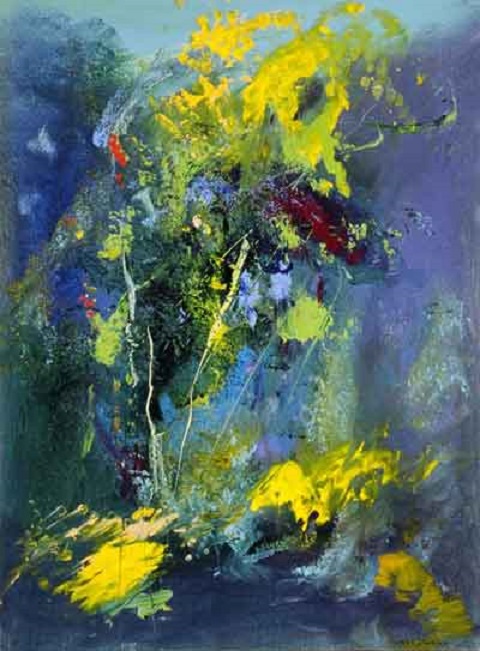Ernesto Treccani (1920 in Milan – 2009), Italian painter and intellectual. Born in Milan on August 26, 1920, he joined very early the art avant-garde groups and movements opposed to Fascist culture. Founder and director at the age of 18 of the magazine "Corrente" (cf. Corrente di Vita), he exhibited his first works at the "Bottega di Corrente" with Renato Birolli, Renato Guttuso, Giuseppe Migneco, Aligi Sassu and later with Bruno Cassinari and Ennio Morlotti at Galleria della Spiga and Corrente.
His first personal exhibition, held at the Galleria Il Milione in Milan, where he exhibited many times during his artistic path, was in 1949. After the Resistance, he was leader of the "Pittura" group and editor of magazines such as Il 45 and Realismo, directed by Raffaele De Grada. In the 1950s his works have been selected for the Venice Biennale, as well as for the exhibition of the Realists held at the Leicester Galleries in London and in New York, where he exhibited with a personal show at the Heller Gallery.
During this period the subjects of his paintings were influenced by his encounter with the rural situation in Calabria and by the urban industrial landscape of Milan and Paris, places where he returned repeatedly over the years.
His first personal exhibition, held at the Galleria Il Milione in Milan, where he exhibited many times during his artistic path, was in 1949. After the Resistance, he was leader of the "Pittura" group and editor of magazines such as Il 45 and Realismo, directed by Raffaele De Grada. In the 1950s his works have been selected for the Venice Biennale, as well as for the exhibition of the Realists held at the Leicester Galleries in London and in New York, where he exhibited with a personal show at the Heller Gallery.
During this period the subjects of his paintings were influenced by his encounter with the rural situation in Calabria and by the urban industrial landscape of Milan and Paris, places where he returned repeatedly over the years.
From the 1960s on, the prolific works and multiple initiatives demonstrate the continuous commitment of Treccani, characterized by a relentless action for the spread of culture and artistic debate. Among the works of this period, the five large paintings inspired by Pavese’s La luna e i falò (1962–63), the cycle of works Da Melissa a Valenza (1964–65), the series of watercolors inspired by a trip to Cuba; later, in 1976, major exhibitions of his work were held in Volgograd, at Pushkin Museum in Moscow and at Hermitage in Saint Petersburg. He held also many personal exhibitions in art galleries and museums in Paris, Berlin, Amsterdam, Barcelona, Stuttgart and São Paulo.
Treccani then developed the various features of his artistic research along parallel lines, continuing to work and exhibit in towns and cities in Italy and abroad, and alternating this “wandering” activity with regular and creative stays in Macugnaga and Forte dei Marmi, places to which the artist was strongly attached in life and painting. In 1978 he founded the Fondazione Corrente,a center for cultural events, exhibitions and debates in the various fields of culture and art, as well as a center for the collection and study of documents related to the period between the birth of the movement and the years of Realism.
Treccani then developed the various features of his artistic research along parallel lines, continuing to work and exhibit in towns and cities in Italy and abroad, and alternating this “wandering” activity with regular and creative stays in Macugnaga and Forte dei Marmi, places to which the artist was strongly attached in life and painting. In 1978 he founded the Fondazione Corrente,a center for cultural events, exhibitions and debates in the various fields of culture and art, as well as a center for the collection and study of documents related to the period between the birth of the movement and the years of Realism.
Treccani was also writer and poet; among his texts, the books Arte per amore, Il segreto dell’arte and Un poco di fiele: poesie e disegni (1940–1970).
In 1989 the City of Milan held a major retrospective exhibition on the artist at the Royal Palace, and another large retrospective of his works was held at Foundation Bandera in Busto Arsizio in 2003. In 2004 he created the cycle of large windows Energia, luci e colori, shown in Lugano, Riga, Budapest and Prague. In 2006 the town of Forte dei Marmi organized the exhibition at the Fortino Le mutazioni del realismo - Opere inedite 2003-06, the result of a renewed search for forms that has its center in color.
In 2008, again at Royal Palace, Treccani participated in the exhibition Corrente, le parole della vita. Opere 1930–1945, with a room set aside for his paintings of that period. A large retrospective exhibition inaugurated the renovated rooms of Palazzo Barberini in Montichiari in May 2009,just a few months before his death, which took place on November 27, 2009, in his beloved House of Swallows.Wikipedia
In 1989 the City of Milan held a major retrospective exhibition on the artist at the Royal Palace, and another large retrospective of his works was held at Foundation Bandera in Busto Arsizio in 2003. In 2004 he created the cycle of large windows Energia, luci e colori, shown in Lugano, Riga, Budapest and Prague. In 2006 the town of Forte dei Marmi organized the exhibition at the Fortino Le mutazioni del realismo - Opere inedite 2003-06, the result of a renewed search for forms that has its center in color.
In 2008, again at Royal Palace, Treccani participated in the exhibition Corrente, le parole della vita. Opere 1930–1945, with a room set aside for his paintings of that period. A large retrospective exhibition inaugurated the renovated rooms of Palazzo Barberini in Montichiari in May 2009,just a few months before his death, which took place on November 27, 2009, in his beloved House of Swallows.Wikipedia











No comments:
Post a Comment